The Allure and Value of Four Carat Alexandrite
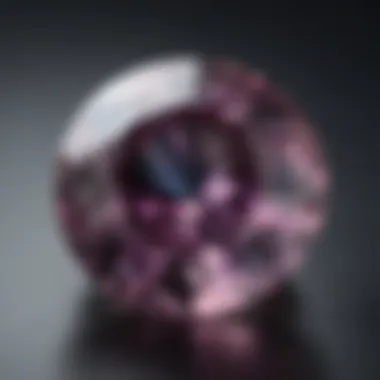
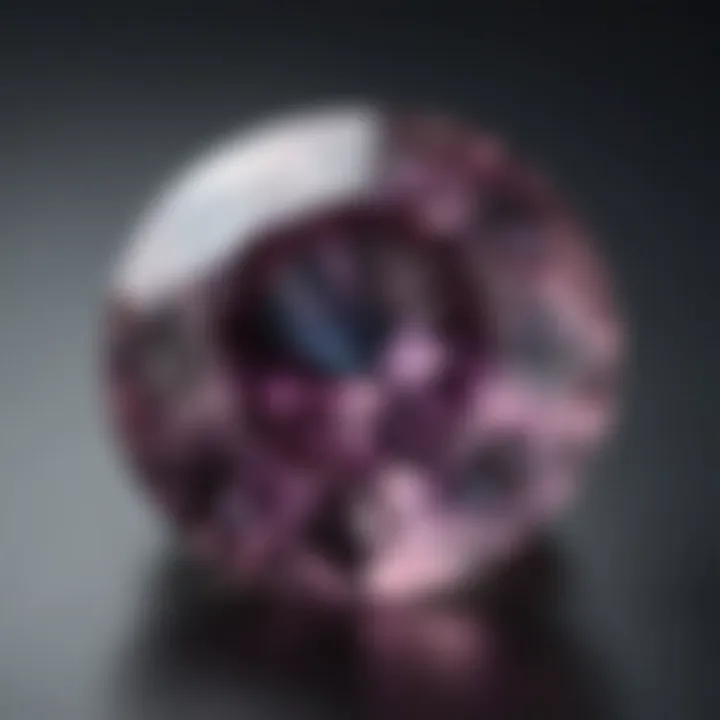
Intro
Four carat alexandrite stands as a true treasure among gemstones, imbued with a charm that transcends mere aesthetics. Its notable characteristic, the ability to shift colors—from lush green in daylight to a deep red under incandescent light—has ignited fascination in gem collectors, jewelry makers, and enthusiasts alike. This article sets out to unravel the rich narrative woven around four carat alexandrite, exploring not just its surface allure, but the deep undercurrents of its geological origins, valuation metrics, and its storied past.
Understanding four carat alexandrite is similar to peeling an onion—layer after layer of intricate details reveals a gem defined by more than its beauty. From the unique properties that set it apart in the gemstone hierarchy, to the nuanced meanings it has held across various cultures, this gemstone certainly deserves in-depth scrutiny. Let's embark on a journey through the world of four carat alexandrite, starting with an overview of this remarkable stone.
Gemstone Overview
Definition and characteristics
Four carat alexandrite represents a specific weight category of this rare gemstone, which belongs to the chrysoberyl family. Its captivating color-change phenomenon is caused by the unique way it absorbs light, a property that enters into both its valuation and desirability. This is not merely a shiny rock; the transformation in hue is a testament to its complexity and rarity. Some key characteristics include:
- Chromatic Shift: The most defining feature of alexandrite is its ability to shift colors, exhibiting variations that can range from greenish blue in daylight to a purplish-red hue in incandescent light.
- Hardness: With a Mohs hardness of 8.5, alexandrite is quite durable, making it suitable for various types of jewelry.
- Clarity and Cut: The quality and craftsmanhsip of cut significantly influence how light interacts with the stone, enhancing its visual appeal.
Classification of gemstones
In the grand tapestry of gemstones, alexandrite doesn't just fit into any classification; it carves its own niche. Gemstones can be categorized based on their composition, origin, or rarity. Alexandrite falls under the category of 'precious stones' due to its rarity and demand. Unlike more common garnets or quartz, alexandrite is sought after by collectors who understand its true worth. Moreover, it is often grouped based on the specific color traits it exhibits. For instance, stones that maintain a clearer and more vibrant shift tend to fetch a higher value, appealing to those who appreciate gemology at a granular level.
"The rarer a gemstone, the more exquisite the stories entwined within it."
Properties of Gemstones
Physical properties
Physical properties of four carat alexandrite illuminate its uniqueness and contribute immensely to its worth:
- Specific Gravity: This stone typically has a specific gravity ranging from 3.68 to 3.70, making it heavier than quartz but lighter than many other gemstones.
- Optical Phenomena: Besides color-change, alexandrite is also known to exhibit strong pleochroism, wherein the stone appears to be different colors when viewed from various angles.
Chemical properties
Delving deeper, the chemical properties of four carat alexandrite involve complex interactions among its constituents. Primarily, it consists of beryllium aluminum oxide but contains trace amounts of chromium, which is responsible for its radiant hues. The presence of chromium is what differentiates alexandrite from its less precious counterparts within the chrysoberyl family. A distinctive feature about this gemstone is that its crystal structure allows for superior color brilliance, an attribute much favored in high-end jewelry.
In summary, four carat alexandrite is not just a beautiful stone; it is a gemstone steeped in rich history, interesting properties, and cultural significance. Understanding these facets is essential for any aficionado interested in appreciating this gemstone's full depth.
Next, we will explore the historical relationships that civilizations have had with four carat alexandrite, shedding light on its cultural significance and ancient lore.
Foreword to Alexandrite
Alexandrite is more than just a stone; it's a marvel of nature and a treasure for collectors. Its vibrant hues shift under different lighting, creating a visual spectacle that can take any gemstone enthusiast's breath away. This section serves as a gateway to understanding this remarkable gemstone, laying out foundational knowledge that paves the way for deeper exploration.
Defining Alexandrite
At its core, alexandrite is a variety of the mineral chrysoberyl, recognized for its stunning color-change ability. When viewed in daylight, it typically displays a captivating green or bluish-green tone. However, under incandescent light, it transforms into a warm red or purplish hue. This phenomenon is a result of the unique crystal structure and the presence of chromium within the stone. Four carat alexandrite stands out not just for its size but also for its vivid contrasts, making it a prized possession among collectors.
Gemstone Classification
Understanding how alexandrite fits into the broader landscape of gemstones provides valuable context. It is classified as a rare gemstone due to its limited availability and extraordinary color properties. Gemstones are typically divided into two categories: precious and semi-precious. Alexandrite, however, straddles both worlds. The rarity and beauty of four carat alexandrite place it squarely in the precious gemstone category, alongside diamonds, rubies, and emeralds.
In terms of grading, alexandrite is evaluated based on its color quality, clarity, cut, and carat weight. Its color change—the hallmark of its allure—is a key factor in determining its value. In the collector's market, larger stones, especially those over four carats with distinct colors, are increasingly hard to find and therefore command higher prices.
"The beauty of alexandrite lies not just in its appearance but in the stories embedded in each stone—tales of deep earth processes and the hands that shape them into wearable art."
As you immerse yourself in the world of alexandrite, consider these foundations as stepping stones toward a richer appreciation of this gemstone. By grasping its definition and classification, you can better understand its significance in both personal collections and the jewelry market.
The Geological Origins of Alexandrite
Understanding the geological origins of alexandrite isn't just an academic exercise; it's crucial for grasping the very essence of this remarkable gemstone. The path that alexandrite takes from deep within the Earth to our jewelry boxes intertwines with not only geology but also history and culture. Knowing where this gem forms and how it comes into being illuminates everything from its rarity to its desirability in the market. This section will reveal the intricacies and elements that make alexandrite unique at the geological level, setting the stage for appreciating its multifaceted nature.
Formation Process
The formation of alexandrite is a meticulous and time-consuming process. This gemstone is a variety of chrysoberyl, and its birth occurs deep within the Earth's crust under specific conditions. First off, you have to consider the role of intense heat and pressure, which together create the right environment for the mineral to crystallize. It’s a little like baking a delicate soufflé, requiring just the right blend of time and temperature.
What’s fascinating is that the presence of chromium in the mineral is what gives alexandrite its captivating color change—from green in daylight to a rich red in incandescent light. This chromatic phenomenon adds layers to its appeal, prompting enthusiasts to seek it out. When the mineral is exposed to long periods of extreme heat, often over millions of years, it develops unique internal structures that contribute to its overall beauty and distinctiveness. What’s astonishing is that no two stones are identical due to these varying conditions.
Sources of Alexandrite
The quest for alexandrite takes gemstone aficionados to several notable regions around the globe, each contributing its own characteristics to the stones extracted. The following locations are paramount in the global supply of alexandrite:
Brazil
Brazil is often the first place that comes to mind when you think of alexandrite. The state's Bahia region is particularly famous for yielding some of the finest specimens. What's advantageous here is the high-quality color range in its stones. The alexandrite from Brazil is known for its remarkable brightness and excellent clarity, making it a prized choice among collectors.

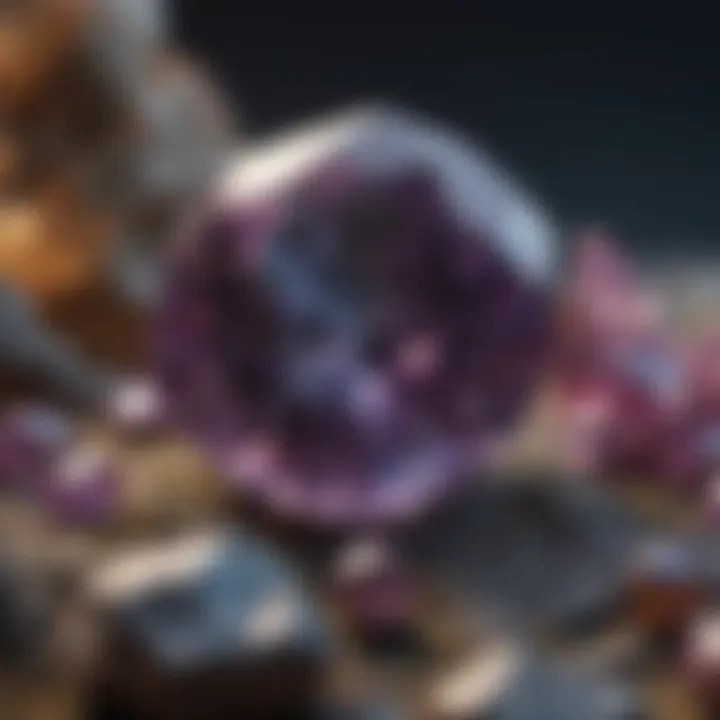
However, one downside is that Brazilian alexandrite tends to be a bit more commercially available, which may make it feel less exclusive. The upside, though, is the variety it offers in terms of quality and color, making it an excellent starting point for those new to gemstone collection.
Russia
When considering the historical context of alexandrite, Russia cannot be overlooked. The Ural Mountains became synonymous with this gem in the 19th century. The stones found here are notorious for their rich hues and striking clarity. Many collectors believe that Russian alexandrite often exhibits a more pronounced color change than that of its Brazilian counterpart.
However, due to the extensive mining in the past, true Russian alexandrite is rather scarce today, moving it into the realm of luxury for the gemstone connoisseur. The rarity of this source makes it a worthy investment, carrying a tale of past opulence along with its exquisite beauty.
Sri Lanka
Sri Lanka presents another chapter in the story of alexandrite. Known for producing a range of gemstones, this island nation provides a unique take on alexandrite, often featuring more subtle color changes and lighter tones. The country’s stones may sometimes lean toward a less vibrant aesthetic than the Brazilian or Russian ones, which can deter some buyers.
However, the allure of Sri Lankan alexandrite lies in its often superior clarity and the fascinating story behind its sources. Collectors appreciate these gems for their uniqueness and for the opportunity to acquire stones from a geographic location steeped in mineral-rich history.
Characteristics of Four Carat Alexandrite
The allure of four carat alexandrite lies not just in its rare beauty, but also in a myriad of characteristics that distinguish it from other gemstones. In this segment, we will investigate the key elements that shape the identity of this remarkable stone, providing readers with a nuanced understanding of what makes four carat alexandrite so revered among gemstone enthusiasts and collectors.
Notably, the interplay of color, clarity, cut, and overall quality influences both the aesthetic appeal and commercial value of alexandrite. Understanding these characteristics helps potential buyers, jewelry designers, and geology lovers appreciate their place in this niche among gemstones.
Color and Clarity
The vibrant hues and clarity of alexandrite are perhaps the most defining features of this gemstone.
Color Change Phenomenon
One of the standout traits of four carat alexandrite is its unique color change phenomenon. This shift in color, depending on the lighting, typically transitions from a lush green in daylight to an alluring purplish-red under incandescent light. This natural marvel not only captivates but also elevates its status as a coveted piece in the gem world. It exhibits a striking visual dynamic that wraps its observers in a flutter of enchantment, making it a remarkable choice for jewelry that seeks to dazzle rather than simply adorn.
The key characteristic of this phenomenon lies in the presence of chromium, which is responsible for the color shifts. This attribute tends to attract enthusiasts who appreciate rare natural phenomena. However, whilst the color change effect is a major draw, it can also present challenges for appraisers. Variations in lighting conditions can make assessing the true color of the gemstone tricky, which is something to consider when purchasing.
Translucency Factors
Another essential aspect is translucency. The translucency of four carat alexandrite significantly contributes to its overall appeal. A well-cut alexandrite should allow light to pass through it, creating a gentle glow and enhancing its colors. This quality is vital in determining how the stone performs in various light conditions, impacting its visual impact.
Translucency can vary among individual stones, with some achieving a near-transparent quality while others might be more opaque. Generally, higher translucency is considered beneficial for both aesthetic and value reasons. However, a few stones might exhibit significant inclusions that could affect light penetration and therefore their overall beauty.
Cut and Carat Weight
Cut and carat weight carry great importance in determining the value of four carat alexandrite. The precision of the cut influences how well it displays its color-changing properties and brilliance. A well-proportioned cut enhances light reflections while maximizing the beauty of its color change, which is crucial for collectors aiming to showcase these stones.
A four carat weight indicates a relatively larger size, making it a significant find for any collector. However, it’s also important to note that larger carat weights do not always equate to a higher value; other factors like color quality and clarity play equally significant roles. A deep understanding of cut design can help gem enthusiasts find that perfect balance between size and aesthetic.
Overall Quality Assessment
In the end, the overall quality of four carat alexandrite is a synthesis of its color, clarity, and cut. Assessing quality requires knowledge of gemstone grading that looks beyond initial visual appeal. Factors such as the uniformity of color, presence of inclusions, and the skill of the jeweler in crafting the cut all contribute to determining its desirability.
"The beauty of a four carat alexandrite is not merely in its weight or color, but also in the intricate dance of light that it performs—each stone telling its own story."
Evaluating these characteristics carefully can provide gemstone enthusiasts with insight into the stone’s true worth and its potential as a cherished piece of jewelry. Proper education about factors like cut, translucency, and color change can significantly enhance the purchasing experience for collectors.
Valuation Criteria for Alexandrite
When it comes to assessing the value of four carat alexandrite, understanding the valuation criteria is essential. Alexandrite, renowned for its vibrant hues and captivating color change, requires careful evaluation to determine both its worth and desirability in the market. The significance of valuation criteria lies in its ability to provide potential buyers and collectors with insights into what makes a stone particularly valuable. This section will delve into the essential elements influencing its valuation and will provide detailed considerations for gemstone enthusiasts.
Market Demand and Supply
Like any luxury gem, the market dynamics of alexandrite greatly influence its price and availability. The rarity of alexandrite, especially in four carat sizes, leads to higher market demand. The limited supply contributes to its allure, often making it a sought-after choice among collectors. In recent years, there has been a growing interest in unique and rare gemstones, particularly those with striking characteristics like those of alexandrite. Location also plays a role; certain sources like Brazil have produced some of the most vivid examples, impacting consumer interest.
Factors Influencing Value
Color Quality
Color quality is paramount when evaluating alexandrite. The stone's ability to change colors—from a vivid green in daylight to a rich purplish-red under incandescent light—sets it apart within the gemstone family. This color change phenomenon is not just a neat trick; it’s a key aspect of its valuation. Collectors typically favor stones that exhibit a strong and distinct color transition. Factors that determine color quality include hue, tone, and saturation. A stone with pure hues and a strong saturation not only captivates the eye but also provides greater investment potential. However, if the stone shows a muddy or overly dark tone, it may significantly dip in value. Thus, a brilliant and vibrant color quality is definitely a beneficial feature for alexandrite.
Carat Weight
Carat weight is another critical factor in determining the value of alexandrite. Generally, larger stones are rarer, and four carat examples are particularly hard to come by. A four carat alexandrite will often command a significantly higher price compared to smaller stones due to its uniqueness.
The characteristic of carat weight directly correlates with value, given the rarity of larger gemstones in the market—this makes it a popular choice among serious collectors. Nonetheless, it is worth noting that weight alone does not dictate value, as the overall quality and characteristics must be balanced with size. Buyers should be cautious of stones that compromise other features such as clarity or color in favor of larger carat weight.
Clarity and Cut


The clarity and cut of an alexandrite are also essential indicators of its quality. Clarity refers to the presence of inclusions or blemishes; fewer imperfections generally mean a more valuable stone. A clear alexandrite can be quite a prize, allowing the mesmerizing color change to shine through without distraction. The cut of the gemstone affects not only its aesthetic appeal but also how well it reflects light—important for showcasing the color-changing properties.
A well-executed cut enhances a stone’s brilliance and depth, so cuts that are precise and allow for optimal light reflection are favorable. Collectors value stones that are cut to emphasize their natural beauty, as this can significantly impact overall appeal. As such, clarity and cut together serve as essential considerations when delving into the valuation of alexandrite.
In summary, the valuation of four carat alexandrite hinges on color quality, carat weight, and the clarity and cut of the stone. Each element contributes to its overall desirability and market price.
Historical Significance of Alexandrite
The historical significance of alexandrite goes beyond its stunning aesthetics and rare qualities. This gemstone has captured the fascination of not just jewelers but also historians, cultural aficionados, and gemstone enthusiasts throughout the ages. Its history intertwines with royal lineage, unique cultural narratives, and even folklore, painting a picture of a gem that has held its ground amid changing times.
Cultural References
Alexandrite is steeped in cultural symbolism and has garnered various references throughout history. For instance, the gem is often associated with the Russian czars, particularly Czar Alexander II, whose name the stone bore. Discovered in the Ural Mountains during the 1830s, it was said the first find was marked by the colors of imperial Russia—green and red—symbolizing hope and victory.
In addition, many ancient cultures attributed mystical properties to alexandrite, believing it offered protection to its wearers and helped in making significant decisions. The unique color-changing phenomenon further fueled these beliefs, leading to its association with balance and transformation, which resonates well within spiritual practices of both Eastern and Western traditions. For modern-day audiences, the stone often appears in tales, readings, and even social media, denoting beauty and strength.
Notable Uses in Jewelry
The allure of alexandrite has not overlooked the world of jewelry. It has graced noteworthy pieces, both historic and contemporary. Many celebrated jewelry houses have crafted exceptional designs utilizing four carat alexandrite, setting it in unique ways to enhance its color-changing abilities. Some of the prominent uses of alexandrite include:
- Rings and Engagement Jewelry: The gem's color-changing property symbolizes change and growth, making it an ideal choice for engagement rings, capturing the essence of a promise.
- Antique and Vintage Jewelry: Alexandrite has made its way into antique pieces, sought after by collectors who appreciate the timelessness it offers.
- Custom Creations by Jewelers: Today's designers appreciate the stone's unique flair, incorporating it in cutting-edge designs that encourage clean lines and bold expressions while still celebrating its inherent charm.
"A four carat alexandrite stands not just as a beautiful accessory; it is a testament to history, art, and sentiment woven together."
The combination of cultural resonance and notable usage in jewelry makes alexandrite a significant gemstone across various epochs and communities. Its historical roots provide a rich backdrop against which each piece featuring this stone tells its own story, elevating it beyond mere ornamentation to something with substance and meaning.
Cultural Importance Across Civilizations
The significance of four carat alexandrite transcends mere aesthetic beauty, delving into the rich tapestry of human culture across various civilizations. This gemstone is not just a feast for the eyes; it embodies a narrative that speaks to the values, beliefs, and artistic expressions of societies throughout history. As we explore its cultural importance, we find a blend of mythology, spirituality, and contemporary relevance that enhances our appreciation for alexandrite.
Mythical Associations
Historically, alexandrite has been associated with a myriad of myths and legends, varying from one culture to another. In ancient times, it was often believed to harbor potent magical properties. For instance, in Imperial Russia, alexandrite was dubbed the "gem of the tsars," said to bring luck and prosperity to its owner, especially the royal family. The color-changing properties of alexandrite have led people to associate the stone with duality – symbolizing balance between opposing forces such as day and night, or light and dark.
Consider this perspective from the ancient Greeks, who connected the stone to Apollo, the god of light. They believed that wearing alexandrite would bring clarity and foresight, allowing the wearer to see beyond the veil of reality. In many indigenous cultures, the gem was considered a bridge between the physical and spiritual realms, used in rituals for protection and healing. These mythical associations enrich the stone's legacy, intertwining it with the dreams and ideals of people long before our time.
Contemporary Significance
In modern times, the relevance of four carat alexandrite has continued to evolve, finding its place in various facets of contemporary culture. It holds a special appeal among gemstone enthusiasts and collectors who appreciate its rarity and unique characteristics. In the jewelry market, alexandrite’s allure lies not only in its captivating color change but also in its story. Jewelry designers often use alexandrite as a statement piece, reflecting personal values such as authenticity and individuality.
Moreover, as consumers become more mindful of their purchases, the cultural significance of ethically sourced stones has gained traction. Many buyers are increasingly scrutinizing the origins of gemstones, favoring those with responsible mining practices. This emphasis on ethical sourcing has imbued alexandrite with a new layer of importance. Now, when someone chooses a four carat alexandrite, they’re not just acquiring a beautiful gemstone but are also participating in a larger conversation about sustainability and the impact of their choices.
"Alexandrite reflects the dualities of nature, serving as a reminder that beauty and responsibility can coexist."
The cultural importance of four carat alexandrite, therefore, stretches from its mythical roots to its modern implications, making it not only a choice for adornment but also a symbol of the evolving values of our time. This dual legacy — combining historical reverence with contemporary relevance — ensures alexandrite remains a revered choice for generations to come.
Care and Maintenance of Alexandrite
Taking care of four carat alexandrite is crucial, not just for its aesthetic appeal but also to protect your investment. This gemstone, celebrated for its striking color change, can be quite delicate. Proper maintenance is essential to ensure its longevity and beauty endure through time and wear. From cleaning to storage practices, understanding these elements can make a world of difference in keeping your alexandrite in pristine condition.
Cleaning Techniques
When it comes to cleaning alexandrite, the golden rule is to be gentle. This gemstone is prone to scratching, so abrasive materials should be avoided like the plague. Here are some practical steps to keep your stone sparkling:
- Soapy Water Soak: Fill a bowl with warm water and add a few drops of mild dish soap. Let your alexandrite sit in this solution for about 10-15 minutes. This helps loosen any debris or oils that may have accumulated on its surface.
- Soft Cloth Wipe: Taking a soft, lint-free cloth, gently wipe your stone to remove any residue. Avoid rough fabrics or paper towels that can create scratches.
- Rinsing: Make sure to rinse your gemstone under clean, lukewarm water to remove any soap. Balance is key – don't let your stone remain in water for too long.
- Drying: Pat it dry carefully with another soft cloth. Avoid using heat sources like hair dryers, as this can damage the stone.
"Regular care ensures that alexandrite not only maintains its brilliance but also holds its value over time."
Storage Recommendations
Storing your four carat alexandrite appropriately can also help minimize the chance of damage. Here are some tips to keep in mind:
- Separate Storage: Store your alexandrite in a soft pouch or a dedicated jewelry box. This will prevent it from coming into contact with harder gemstones or metals, which can cause chipping or scratching.
- Avoid Humidity: Keep the storage area dry. Excess humidity can lead to the formation of moisture on the stone, potentially affecting its clarity and overall quality. A silica gel pack can be a great addition to absorb moisture in the storage area.
- Regular Checks: Make it a point to check on your gemstone every few months. This will help catch any potential issues like unexpected scratches or fading of color early on.
Incorporating these cleaning techniques and storage recommendations into your care routine will go a long way toward preserving the striking qualities of four carat alexandrite. These gemstones are not just lovely to look at; they're also worth the effort you put into maintaining them.
Buying Alexandrite: Expert Guidance
Acquiring a four carat alexandrite is no small feat; it's akin to navigating a maze laden with hidden treasures and pitfalls. This section aims to shed light on the critical aspects of purchasing such a precious gemstone. Understanding the nuances involved can substantially enhance one’s experience, paving the way for an informed decision that harmonizes passion and investment. While there’s much to consider, the guidance provided here is geared towards equipping buyers with the knowledge necessary to avoid common missteps and make a wise purchase.
Identifying Quality Stones
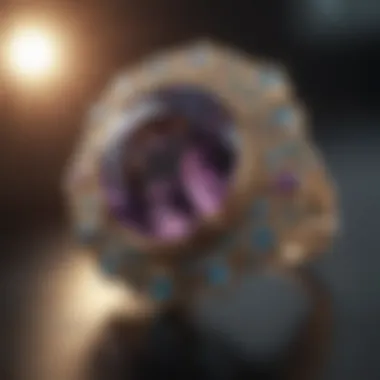
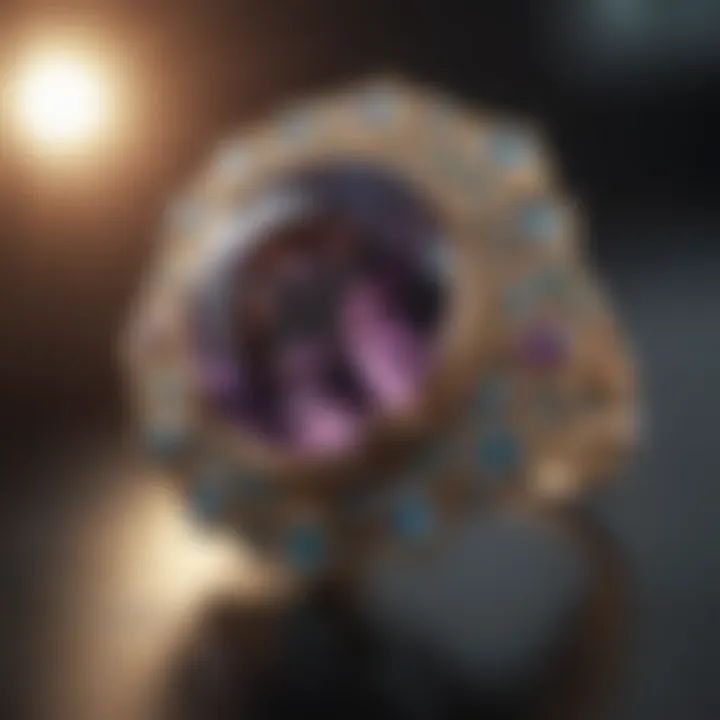
When searching for quality stones, several factors come into play. Noteworthy characteristics include color, clarity, and cut. To start, the color of alexandrite is its most resounding feature, often showcasing a stunning color shift—from a verdant green in daylight to warm purples and reds under incandescent light. To identify an exemplary stone, focus on:
- Evenness of Color: Look for those that exhibit a uniform hue, avoiding stones with patches or hues that are too light or too dark.
- Intensity of Color Change: A stone's ability to vividly change colors is paramount; the more dramatic the shift, the more valuable.
- Clarity: Ideally, it should be free from noticeable inclusions. However, some inclusions can be acceptable if they don't overshadow the overall beauty.
Being a discerning buyer also means recognizing signs of authenticity. Asking for a certificate from a reputable gemological lab can establish the stone’s credibility.
Navigating the Market
Buying alexandrite isn’t just about picking a beautiful stone; understanding where to find it is equally important. The two main avenues typically pursued are purchasing from trusted jewelers or exploring online options.
Trusted Jewelers
Navigating through local jewelers can offer a tactile experience that online shopping simply can't provide. Trusted jewelers have established relationships in the industry, often showcasing their expertise in gemstones particularly well. A few reasons why one may prefer this route include:
- Personal Service: Jewelers can provide tailored advice, helping refine a buyer's needs and preferences.
- Verification of Authenticity: With their expertise, they can facilitate direct evaluation of the gem's quality.
- Immediate Ownership: Nothing beats the thrill of immediately being able to hold the gemstone in one’s hands, allowing for a deeper personal connection.
However, it’s essential to exercise caution. Not every jeweler carries the same level of integrity. Researching their reputation and seeking reviews can be a prudent strategy.
Online Options
Online marketplaces can open up a whole new world of choices. These platforms often showcase a broader selection than local shops, making them a magnet for enthusiasts and collectors. Some pertinent details on online options include:
- Variety of Choices: With multiple dealers in one place, buyers can compare prices and qualities effortlessly.
- Convenience: Browsing at any hour of the day from the comfort of home means ample flexibility in shopping.
- Access to Global Market: Online options can expose buyers to rare stones that local jewelers may not carry.
On the flip side, there are potential downsides. You miss out on the tactile experience of physically inspecting the gemstone. Plus, it can be challenging to verify the seller's authenticity, making research mandatory before making a purchase.
In summary, whether opting for trusted jewelers or online vendors, the key is knowledge and vigilance. Each avenue has its benefits and downsides, and weighing them carefully can lead to a satisfying purchase. As you've learned, every step you take matters, and being armed with information transforms what could be a daunting venture into an exhilarating exploration.
Exploring Metaphysical Properties
The world of gemstones often transcends mere aesthetics, and four carat alexandrite is no exception. Beyond its captivating color transitions and striking appearance, this gemstone is historically rooted in a variety of metaphysical beliefs. At the core of exploring its metaphysical properties lies the idea that these stones can influence the mind and body in significant ways. For many, the allure of four carat alexandrite doesn’t just bubble up from its beauty; it also revolves around the potential benefits of owning such a mystical gemstone.
Healing Attributes
When it comes to healing, four carat alexandrite has garnered attention because of its reputed ability to aid emotional balance. Many believe that this gemstone supports the wearer in dealing with anxiety and enhancing emotional resilience. It's said to facilitate a deeper understanding of one's self and help uncover hidden aspects of our personality. This might sound a bit fictitious to some, but anecdotal evidence suggests that folks feel more at peace when they have this stone close.
Moreover, it’s thought that alexandrite can promote physical healing as well. Some claim that it encourages detoxification in the body and improves overall health. Its unique structure is said to connect to the heart chakra, helping to clear emotional blockages. It really seems to play into the notion that physical and emotional realms intertwine more than we often acknowledge.
"The gemstone acts like a mirror, reflecting one's emotions and guiding them towards self-discovery."
Additionally, many who practice crystal healing recommend meditating with four carat alexandrite to invoke a sense of clarity and to tap into its purported healing energies. Whether it truly heals or simply serves as a reminder to care for one's emotional well-being is up for debate, but the intention behind using these stones unlocks deeper conversations about health and mindfulness.
Spiritual Significance
Shifting to the spiritual aspect, four carat alexandrite is frequently associated with transformation and growth. This gemstone is said to guide individuals on their spiritual journeys by showing them change as a necessary part of life. Just like its color shifts from green to red, it symbolizes adaptability and renewal, reminding us that changes in our lives can lead to personal breakthroughs.
It’s intriguing how some cultures link this stone to the astrological sign of Gemini, reinforcing the idea of duality and the notion that one can embody multiple aspects of their personality. The versatility of alexandrite encourages its wearers to embrace their complexity and navigate life's various layers.
Furthermore, many believe that four carat alexandrite enhances intuition and psychic abilities. Some users report heightened awareness when wearing this stone, which may lead to a deeper connection with one’s spiritual guides. This could manifest as a better ability to understand life events, or perhaps even an awakening to one’s purpose.
Ultimately, exploring the metaphysical properties of four carat alexandrite reveals a tapestry of meanings that go beyond what can be seen. From healing emotional wounds to guiding one's spiritual path, this gemstone's significance runs deep, making it a treasure not just to adorn oneself, but to reflect upon one's journey as well.
Ethical Sourcing Practices
The conversation about gemstones today isn't only focused on their beauty or rarity; it's increasingly about how they are obtained. Ethical sourcing practices are paramount in ensuring that four carat alexandrite, along with other gemstones, is mined and sold with respect for human rights and the environment. This section dives into the significance of these practices, looking at responsible mining and the essential role that certification plays in the industry.
Understanding Responsible Mining
When discussing responsible mining, it's crucial to recognize that the process extends beyond simply extracting stones from the earth. It's about ensuring that miners work in safe conditions and are compensated fairly for their labor. In many regions, the mining of gemstones can lead to extensive environmental damage if not handled properly. Responsible mining aims to minimize this impact.
This involves practices like:
- Utilizing green technologies that reduce harmful waste.
- Implementing reclamation strategies that restore land once mining has taken place.
- Supporting local communities through economic initiatives, education, and infrastructure development.
Moreover, the mining process itself should be transparent. Consumers today want to know not only where their gemstones come from, but how they were sourced. It's becoming more common for jewelers to offer detailed information about the origins of their alexandrite, which satisfies an ethically minded audience.
The Role of Certification
Certification acts as a watchdog of sorts in the gemstone market. It provides critical assurance to buyers that their four carat alexandrite has been sourced ethically. Organizations and certifying bodies evaluate mines and the practices of the companies involved in the mining process, ensuring they meet specific sustainability and ethical standards.
Many gemstone enthusiasts look for certifications when purchasing alexandrite. Such certifications can include criteria about:
- Environmental impact assessments
- Fair labor practices
- Transparency in supply chains
Additionally, certification can enhance the overall market value of alexandrite. A certified stone is often seen as a sign of quality and responsibility, making it an attractive option for both collectors and jewelers.
In many ways, certification reassures buyers that their investment contributes to more than just aesthetic pleasure; it supports ethical and sustainable practices.
Ethical sourcing not only uplifts communities but also meets the growing demands of conscious consumers, leading to a better industry overall.
By understanding and participating in ethical sourcing practices, collectors and enthusiasts can feel a sense of pride in their acquisitions of alexandrite. They contribute to a movement that regards the origins of these vibrant gems as crucial as the gems themselves.



